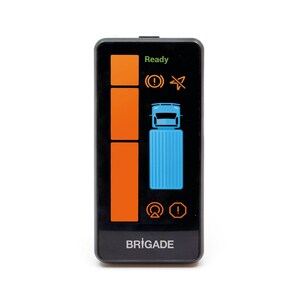Brigade Electronics: Cycling Safety - Preventing Fatalities for e-bike and Electric Scooter Users English
PORTLAND, Indiana, Sept. 9, 2019 /PRNewswire/ -- A recent report estimates that sales of electric bicycles are set to grow to $21 billion by 2024. As the popularity of electric bicycles and electric scooters grows, the potential for road traffic collisions increases. Corey Heniser, a vehicle safety expert at Brigade Electronics INC, discusses how operators of trucks and other large vehicles can help protect vulnerable road users.
Electric bicycles, or e-bikes, are fast becoming commonplace on streets across the country with a recent survey revealing that 65% of riders choosing to replace car trips as their primary reason for investing in an e-bike. As well as the associated health benefits for riders, e-bikes are environmentally friendly, economical and allow cyclists to carry equipment and tackle steep hills with ease. This offers a real advantage to people with physical limitations and the elderly, who might struggle to use traditional push bikes. However, as the popularity of e-bikes and electric scooters has grown so has the potential for road traffic collisions – particularly in built-up areas and on congested city streets.
In the US, anyone over the age of 16 can ride an electric bike, and all electric scooters must be insured and fitted with a plate as proof. An annual study of electric bike sales in the United States, carried out by eCycleElectric, revealed that 263,000 were bought in 2017. This figure is set to grow considerably over the coming years.
Although many cities have dedicated bike lanes, which can be used by e-bikes and scooters, cyclist fatalities are still occurring at an alarming rate. In New York City alone, there have already been 18 cyclist deaths this year – many of them caused by collisions with large vehicles. This is despite the introduction of Vision Zero – a directive for reducing vulnerable road user fatalities to zero by 2024. As the popularity of e-bikes and scooters grows, the potential for road traffic collisions will increase with it.
Atlanta has recently announced it will ban the use of electric scooters during nighttime hours following a series of fatalities which included collisions with a truck and a bus.
As with other vulnerable road users, riders of e-bikes and scooters aren't always easily visible to drivers of large vehicles. Complex blind spots on trucks, along with poor visibility due to bad weather conditions, are a major contributing factor to collisions and are often the main reasons why pedestrians and cyclists are killed or injured.
Safety for larger vehicles has dramatically improved in recent years, with many operators opting to invest in stringent safety procedures, including fitting vehicle safety systems to eliminate vehicle blind spots.
However, as roads get busier and e-bikes start to gain in popularity, operators will need to review these systems to ensure they are doing everything they can to eliminate blind spots and prevent collisions.
While large mirrors have traditionally been used, they cannot completely eliminate blind spots. Research has shown that in the time it takes to scan four mirrors, assess and then react to hazards, a vehicle could travel as far as 32 feet. However, camera safety systems fitted to the vehicle can eliminate blind spots by providing a complete view of the surrounding area in one image, which the driver can see on a screen inside the vehicle.
Brigade has spent years researching and pioneering such technology. Its Backeye®360, for example, combines images from ultra wide-angle cameras, resulting in a 'bird's-eye view' of the vehicle and surrounding area in real time, meaning drivers can clearly see pedestrians, cyclists, and objects as they maneuver their vehicles.
Simple reversing alarms have long been a solution to alerting those on the ground, but research has shown that old-fashioned tonal alarms may be adding to the problem as pedestrians and cyclists cannot always locate the direction from which the alarm originates. Multi-frequency alarms are solving this problem. Rather than the traditional 'beep beep' of tonal alarms, they create a 'ssh-ssh' sound which is gentle on the ear and dissipates quickly, meaning the alarm can be instantly located and heard only in the danger zone.
While technology is a step towards preventing deaths and solving safety issues, operators need to be mindful that relying on safety systems will not completely solve the problem. Operators should also be committed to implementing robust procedures, regular training and reviews to assist drivers - only then will roads be safer for everyone.
https://brigade-electronics.com
SOURCE Brigade Electronics

WANT YOUR COMPANY'S NEWS FEATURED ON PRNEWSWIRE.COM?
Newsrooms &
Influencers
Digital Media
Outlets
Journalists
Opted In





Share this article